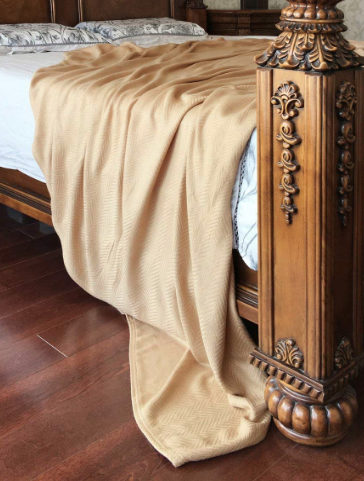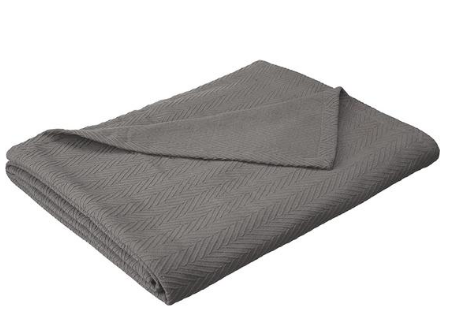How to Choose the Right Summer Blanket for You
To determine which summer blanket is right for you, it can be helpful to think about some of the most important elements of this type of blanket.
Material
A natural starting point for evaluating a blanket is looking at its materials. Generally you don’t want something very heavy in a summer blanket. Light and airy materials typically garner the most customer satisfaction and typically with a low to moderate amount of fill. At the same time, there should be enough material to provide a bit of warmth and to give you that cozy feeling of being wrapped up in a blanket. Some of the specific materials used in summer blankets include:
- Cotton: you’re almost certainly familiar with cotton already, and this is a popular choice for summer blankets because it is soft, pulls moisture away from the body, and can be woven to be very airy.
- Linen: this is a material derived from the flax plant that has a heavier feel but that is excellent at staying cool and allowing plenty of airflow around the body. It is not soft like cotton but can give a comforting feel around the body.
- Silk: this extremely smooth material is naturally cool to the touch and is extremely light, making it a quality material for a summer blanket.
- Down: down comes from the underside of the feathers of geese and ducks and is most commonly used in winter blankets because of its powerful insulating properties. However, down can be used in lesser quantities in a summer blanket allowing customers to take advantage of down’s lightness and softness.
- Wool: this is a naturally breathable and moisture-wicking material but that can also give warmth when needed. Wool can have more tedious washing requirements although washable wool can go in the washing machine.
- Polyester: this synthetic material can be formulated to have a feel like down or one closer to cotton (although not quite as soft or absorbent). It is often a low-cost option and one that is lightweight and easy to clean.
- Natural and organic materials: fibers for summer blankets may be derived from natural materials (such as bamboo). These are often lighter and breathable and can provide a nice alternative to the more standard bedding materials. Keep in mind that not all natural materials are organic. Whether you prefer natural or organic materials depends on your personal preferences as well as your budget and other factors (such as allergies or chemical sensitivities).
Weave
The weave of a blanket is something that you’ll notice based both on how a blanket looks and how it holds in heat. The tighter the weave, the more likely a blanket is to be warm and to keep heat in.
You’re also likely to come across some specific terminology as it relates to the weave. For example, percale is a type of cotton weave that layers vertical and horizontal yarns in a 1:1 ratio. This gives percale lots of breathability but not quite as much softness as sateen, another type of cotton weave that produces a smoother but slightly less breathable material. Twill is a diagonally-patterned weave with more pronounced texture that can feel rougher. A waffle weave creates a pattern that looks like its name, and these tend to be more breathable and have a distinct look. Knit weaves usually leave larger holes in the fabric, which means more breathability but less heat retention.
Durability
When you buy a new blanket, you want to know that it’s going to last plenty of time to make your investment worth it. Durability will be affected by the material, the type of weave, the thread count, and how you use the blanket. Materials like cotton tend to hold up well, especially if it’s a quality thread count and cotton fabric. Cotton and polyester are also usually easier to wash without damaging the material. Silk and down, on the other hand, can be durable but require more attention to specific washing instructions.
The more you use the blanket, obviously, the more wear-and-tear it will have. In addition, with more use, it may require more frequent cleaning that over time will break down the materials. However, most summer blankets should last for several years.
Cleaning
When it’s hot, you sweat more, and this can mean that a summer blanket gets dirty faster. This is especially true with materials that rapidly absorb moisture and if you use your summer blanket without a top sheet. As a result, you’ll want to wash your summer blanket with some frequency, and this can make simple cleaning a nice plus. Materials like cotton and polyester are normally machine-washable while materials like silk, wool, and down usually require more careful cleaning.
Other Things to Consider
Other factors to consider as you select among different summer blankets include:
Style/Pattern
Since you likely will use your summer blanket without other bedding or blankets, it will normally be visible. This puts more priority on finding a blanket that fits with your personal sense of style, and this is even more true if you want to use a summer blanket as a living room throw. Look at the decor in your home and your bedroom to get a sense of what colors or patterns might look best.
Return Policy
A customer-friendly return policy can be a huge benefit, especially if you’re thinking about buying a more expensive summer blanket. The ability to return a blanket within a set period of time (usually 30 days) can help give you peace of mind that you won’t get stuck with a blanket that doesn’t work for you. Whenever possible, look for a blanket that comes with the option for returns or at least exchanges in the event that you don’t love it.



